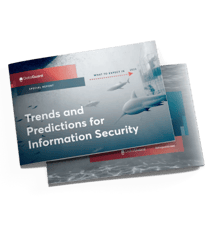In recent years, online threats and cyber-attacks have increased at a steady pace. In fact, cyber-attacks in 2022 reached an all-time high with a 38% increase compared to the previous year. This has become a big concern for companies across all industries, but more so for the people in charge of these companies.
To mitigate the risks of cyber-attacks and safeguard their companies, CEOs and top-level executives are in charge of creating robust cybersecurity strategies. They must foster a culture of cybersecurity within the company and ensure that everyone is responsible for keeping data safe.
In this article, we'll cover 6 steps CEOs can take to improve their company's cybersecurity culture and discuss what they can do to strengthen their current cybersecurity plan and its benefits.
Why is cybersecurity important now more than ever?
Cybersecurity has always been an important topic for businesses dealing with sensitive data. Since 2020, it has become more important because of major changes in the online landscape. The most significant changes are:
- The cost of conducting a cyber-attack has significantly declined. Malicious actors constantly find newer and more efficient ways of breaching information systems, so the frequency of cyber-attacks has increased.
- More people are now working from home after the Covid-19 pandemic. They use unprotected devices, thus expanding the cyber-attack surface even more. Attackers have now jumped at the opportunity to exploit new vulnerabilities in unsuspecting employees.
This is only the tip of the iceberg of cyber threats that individuals and companies face, and it is also the reason why cybersecurity strategies are so important. Implementing a sound cybersecurity strategy can provide benefits like:
- Competitive advantage - Investing in cybersecurity measures can help to build trust and reputation, giving companies an edge over their competitors. It assures customers and partners that their data is safe.
- Business continuity - Cybersecurity measures protect companies against disruptions caused by cyber-attacks. By investing in cybersecurity now, CEOs can protect their companies from the reputational and financial damage resulting from a cyber-attack and ensure the smooth operation of business processes.
- Innovation and growth - Cybersecurity enables innovation and growth by ensuring the safe use of emerging technologies like the Internet of Things (IoT), cloud computing, and artificial intelligence. A robust cybersecurity program can help to unlock the potential of these technologies by ensuring that they are implemented securely and in compliance with regulations. This can lead to new business opportunities and revenue streams.
Building a strong cybersecurity program is a collective effort. As IT departments and chief information security officers (CISO) take the lead, CEOs, boards, and the C-suite can strengthen cybersecurity programs and integrate them into business strategies.
Here’s how.
What can CEOs do to improve cybersecurity?
1. Create a cybersecurity culture
Most companies now have cybersecurity education programs for their employees. These programs aim to train them on how to recognise potential network threats. They must also be updated with emerging security risks to be effective.
As a CEO, it's important to take an active role in supporting security awareness programs. By doing this, they can communicate the importance of promoting cybersecurity awareness to employees. The CEO is also responsible for ensuring that all employees, managers, and executives comply with the program.
By being involved in the training program, CEOs can evaluate its effectiveness. They can monitor how many users have completed the training and identify which sections they found most helpful. Additionally, employee surveys can provide valuable feedback, highlighting areas that need improvement.
2. Align cybersecurity with business goals
Cybersecurity shouldn't be seen as a separate task; it should be a part of the company’s overall strategy. CEOs should ensure that the company's cybersecurity goals align with its overall business objectives, and that the company's risk management framework includes cybersecurity initiatives.
This way, cybersecurity is thought about in all company levels and gets the resources and attention it needs.
3. Conduct regular risk assessments
An annual security assessment is a good way to find and stop security breaches.
Based on the size and complexity of the network, along with the risk assessment results, the CEO decides how to divide up resources and security measures. Depending on the situation, some areas may need more attention than others, or a more general approach may be enough.
Overall, the CEO and board decide how much risk the company can handle. Even with a risk assessment, getting rid of all security risks is impossible, but the assessment can help find places where hackers might try to get in. This lets the company use its limited resources to protect those areas.
4. Create a working relationship with the CISO
The CISO plays a critical role in educating company executives, including the CEO, on cyber risks and promoting a culture of cyber defence.
In the past few years, CISOs have become more involved with the company's leadership team. In fact, half of all companies now have a CISO on their executive leadership team. By working with the CISO, CEOs can conduct risk assessments and review the findings together.
CISOs can also provide good insights into improving security when new projects are being planned. It's easier to add security measures when the program is in the development phase rather than after it's been made. The CISO can work with each team to find ways to meet project goals consistent with security rules and ensure that everyone is responsible for upholding cybersecurity best practices.
5. Strengthen and adapt security protocols
A risk assessment helps identify weak areas in your IT security that need improvement. Whenever your company adds new equipment or software, it's important to ensure they don't compromise the existing network security. Cybersecurity becomes increasingly important as you add new tools.
By 2025, there will be an estimated 41.6 billion devices connected to the internet, and even though these devices can be useful, they can also be dangerous if they are not protected. To reduce or get rid of these risks, it's important to keep your security protocols up to date.
6. Plan for incident response
Security breaches and incidents can cause financial and reputational damage to companies in a short period, so it is critical to have a plan for how to handle such situations.
If a security breach occurs, it is essential to react quickly. Identify when and where the breach occurred and work with the security team to gather information. This will help you determine if any data was stolen and provide a complete picture of the situation. Staying on top of the issue minimises the damage and allows for quick recovery.
In addition to these steps, legal requirements can also be leveraged to increase cybersecurity in a company. For instance, the NIS2 Directive which focuses solely on cybersecurity can greatly benefit CEOs.
What is the NIS2 Directive, and how can CEOs leverage it to improve cybersecurity?
The NIS2 Directive is designed to improve the overall cybersecurity of EU member states by imposing laws on providers of essential services and digital services. CEOs can use this directive to enhance the security of their companies by evaluating and identifying the most important assets and systems for running the company. By knowing how important these assets are, they can make sure that the right security measures are taken to protect them.
NIS2 compliance can help identify gaps in existing security measures and assist in implementing necessary changes. The NIS2 requirements cover a broad range of areas, including:
- Organisational security
- Risk management
- Incident handling, and
- Security monitoring.
By meeting these requirements, CEOs can build a strong foundation for security, manage risks well, and respond to security incidents.
Key takeaway
With the increasing frequency and sophistication of cyber-attacks, CEOs have a significant responsibility to protect their companies from such threats. It is essential that they stay vigilant and proactive to keep their companies safe and secure. To do this, they, along with top-level management, must continuously improve the cybersecurity culture in their company and maintain a strategy that adapts with evolving threats.
By prioritising cybersecurity in this way, CEOs can safeguard their company’s data assets, protect against financial and reputational damage, and stay ahead of the curve.
How can DataGuard help?
At DataGuard, we recognise the critical importance of safeguarding data and are committed to staying up-to-date with the latest cybersecurity best practices. We understand that as your business grows, your information becomes more complex and valuable, making it more susceptible to theft or loss. Any breaches or downtime can significantly impact your business operations.
However, with a robust Information Security Management System (ISMS) and the right processes in place, you can significantly reduce the likelihood and impact of future risks. With ISO 27001 Certification, you can strengthen your cybersecurity posture and protect your business from potential cyber-attacks.
Contact us today to learn how we can help you protect your business and mitigate cybersecurity risks.


InfoSec trends & predictions CEOs should have on their mind
Learn about the latest trends for 2023 and what experts predict in Information Security.
Download for free






